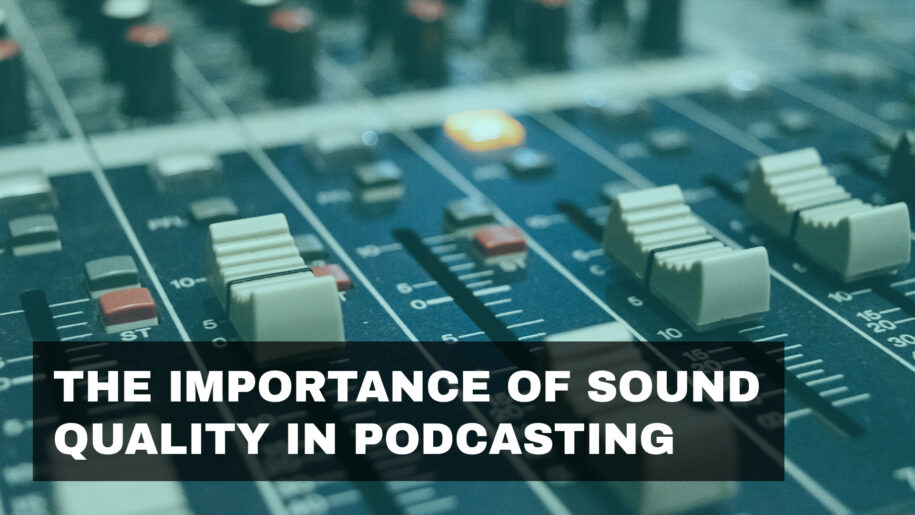Sound quality is the backbone of any successful podcast. It plays a crucial role in attracting and retaining listeners, enhancing the overall experience, and ensuring your message is delivered clearly. In this blog post, we’ll explore why sound quality matters and how to achieve it in your podcasting efforts.
1. First Impressions Matter
The first few seconds of your podcast are critical. High-quality sound immediately conveys professionalism and keeps listeners engaged. Poor audio quality, on the other hand, can turn listeners away before they even hear your content.
Example: “Listeners are likely to abandon a podcast with muffled audio or background noise within the first few minutes.”
2. Enhances Listener Experience
Clear and crisp audio makes it easier for listeners to follow your conversation and absorb the information you’re sharing. Good sound quality reduces listener fatigue and makes your podcast more enjoyable.
Example: “Podcasts with excellent sound quality often have higher listener retention rates and more positive reviews.”
3. Improves Accessibility
High-quality sound ensures that your content is accessible to all listeners, including those with hearing impairments. Clear audio makes it easier to produce accurate transcripts, which can be crucial for accessibility and SEO.
Example: “Clear audio recordings facilitate the creation of accurate transcripts, enhancing accessibility and search engine visibility.”
4. Reflects Your Brand
Your podcast is a reflection of your brand. High-quality audio signals that you are professional and dedicated to providing the best experience for your listeners. It builds trust and credibility with your audience.
Example: “A podcast with professional sound quality can enhance your brand’s reputation and credibility.”
5. Technical Aspects of Sound Quality
Achieving high sound quality involves several technical aspects, including microphone choice, recording environment, and editing techniques. Investing in the right equipment and learning basic audio editing skills can make a significant difference.
Example: “Using a dynamic microphone and recording in a sound-treated environment can drastically improve your podcast’s audio quality.”
6. Tips for Achieving High-Quality Sound
Here are some practical tips to ensure your podcast sounds professional and engaging:
Choose the Right Microphone
Invest in a good-quality microphone. USB microphones are user-friendly and suitable for beginners, while XLR microphones offer higher sound quality for advanced podcasters.
Example: “The Audio-Technica ATR2100x-USB is a great starting point for podcasters looking for a reliable and affordable microphone.”
Create a Suitable Recording Environment
Recording in a quiet, sound-treated space minimizes background noise and echoes. Use acoustic panels or soft furnishings to reduce sound reflections.
Example: “Avoid recording in large, empty rooms with hard surfaces. Instead, choose a small, carpeted room with curtains and cushions.”
Use Pop Filters and Shock Mounts
Pop filters reduce plosive sounds (like “p” and “b”), and shock mounts prevent vibrations from affecting your microphone.
Example: “A pop filter is essential for any podcaster. It ensures that your speech sounds clear and professional.”
Edit for Perfection
Post-production editing can enhance your sound quality. Remove background noise, balance audio levels, and add intro/outro music using software like Audacity, GarageBand, or Adobe Audition.
Example: “Editing software allows you to polish your recordings by removing unwanted noise and balancing audio levels.”
Sound quality is a vital component of a successful podcast. It affects listener engagement, accessibility, and your brand’s reputation. By investing in the right equipment, creating an optimal recording environment, and honing your editing skills, you can ensure your podcast stands out in the crowded podcasting landscape.
Additional Tips
- Consistent Volume Levels: Ensure all speakers are at a consistent volume to avoid sudden loud or quiet moments.
- Monitor Your Recordings: Use headphones to monitor your recordings in real-time, ensuring immediate identification and correction of any issues.
- Regularly Update Equipment: Keep your equipment up-to-date and replace worn-out components to maintain high sound quality.
By prioritizing sound quality, you’ll create a podcast that not only attracts listeners but also keeps them coming back for more.


